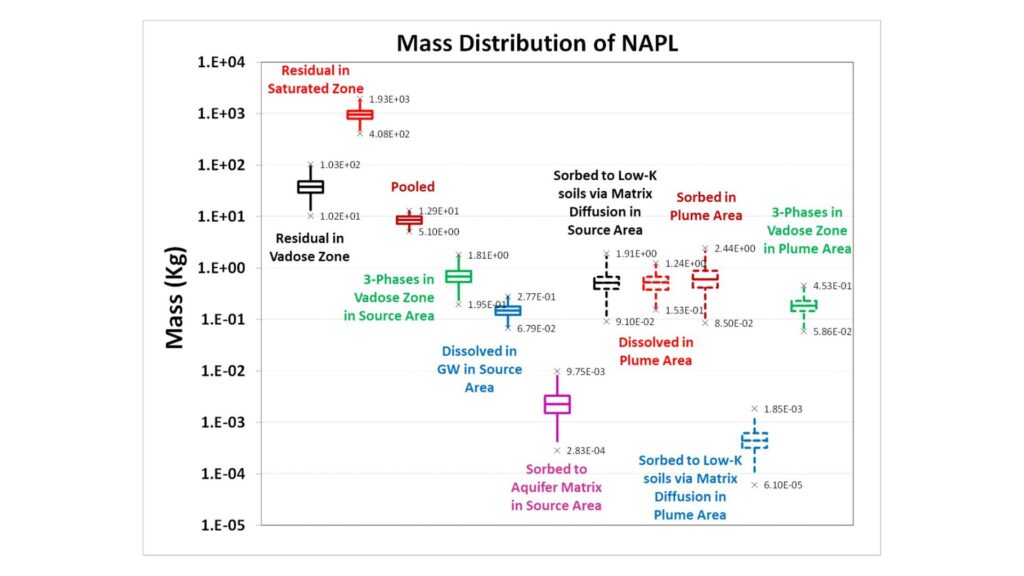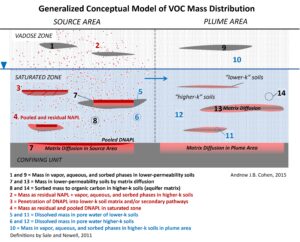Developed Excel-based VBA program used to assess if NAPL is present in the subsurface based on user-defined soil, groundwater, or soil gas concentrations. Program also performs estimates of NAPL mass distribution (free-phase, dissolved, vapor, and sorbed) and considers the uncertainty of chemical and field properties via Monte Carlo calculations.
The Excel-based tool developed for DNAPL assessment provides a comprehensive and probabilistic approach to estimating the presence and distribution of NAPL in the subsurface. It integrates 14 distinct compartments to account for the complexity of contaminant behavior across different geological settings, allowing for a detailed evaluation of NAPL partitioning and mass distribution. The model is designed to work within a box-model framework, incorporating both high-permeability (advection-dominated) and low-permeability (diffusion-dominated) soils, while also considering uncertainty through Monte Carlo simulations.
The tool systematically divides the contaminated subsurface into two primary areas: the source area and the plume area, further subdivided into 14 compartments to capture mass stored in different phases—vapor, sorbed, dissolved, and free-phase NAPL—across various hydrogeologic settings. Within the source area, it evaluates mass distribution in: (1) vapor, sorbed, and aqueous phases in low-permeability vadose zone soils, (2) higher-permeability vadose zone soils, (3) NAPL trapped in the matrix of low-permeability source zone soils, (4) residual and pooled NAPL in the saturated zone, (5) aqueous mass within low-permeability lenses, (6) dissolved mass in higher-permeability saturated soils, (7) mass diffused into low-permeability soils in the saturated zone, and (8) mass sorbed to organic carbon in the saturated source area. Similarly, within the plume area, it accounts for: (9) mass stored in low-permeability vadose zone soils, (10) vapor, sorbed, and aqueous phases in higher-permeability vadose zone soils, (11) dissolved mass in low-permeability lenses of the saturated zone, (12) dissolved mass in higher-permeability saturated soils, (13) mass diffused into low-permeability soils in the plume area, and (14) mass sorbed to organic carbon in the higher-permeability soils of the plume area.
A key feature of this tool is its ability to quantify uncertainty in NAPL mass estimates by allowing users to input ranges for critical soil and chemical properties. This enables the tool to generate probability distributions for each compartment using Monte Carlo simulations, rather than relying on single-point estimates that may not fully capture real-world variability. The output is presented through box-and-whisker plots, illustrating the range and distribution of possible NAPL mass values, allowing for a more robust and defensible assessment of subsurface contamination.
Another unique aspect is the tool’s consideration of matrix diffusion effects, particularly in low-permeability soils, where dissolved-phase contaminants can slowly diffuse in and out of the soil matrix over time, influencing long-term plume behavior. Unlike simpler mass estimation models, this tool accounts for the fact that NAPL does not behave as a homogeneously distributed phase but is instead heterogeneously distributed within different lithologic zones, which can significantly affect remediation strategies.


